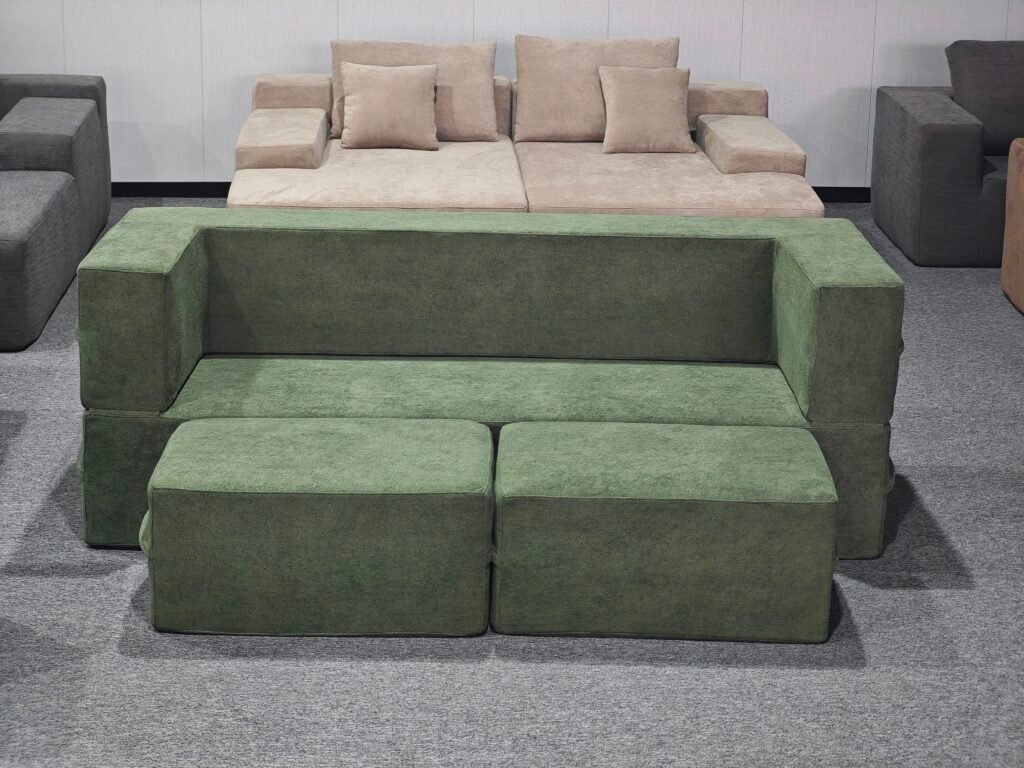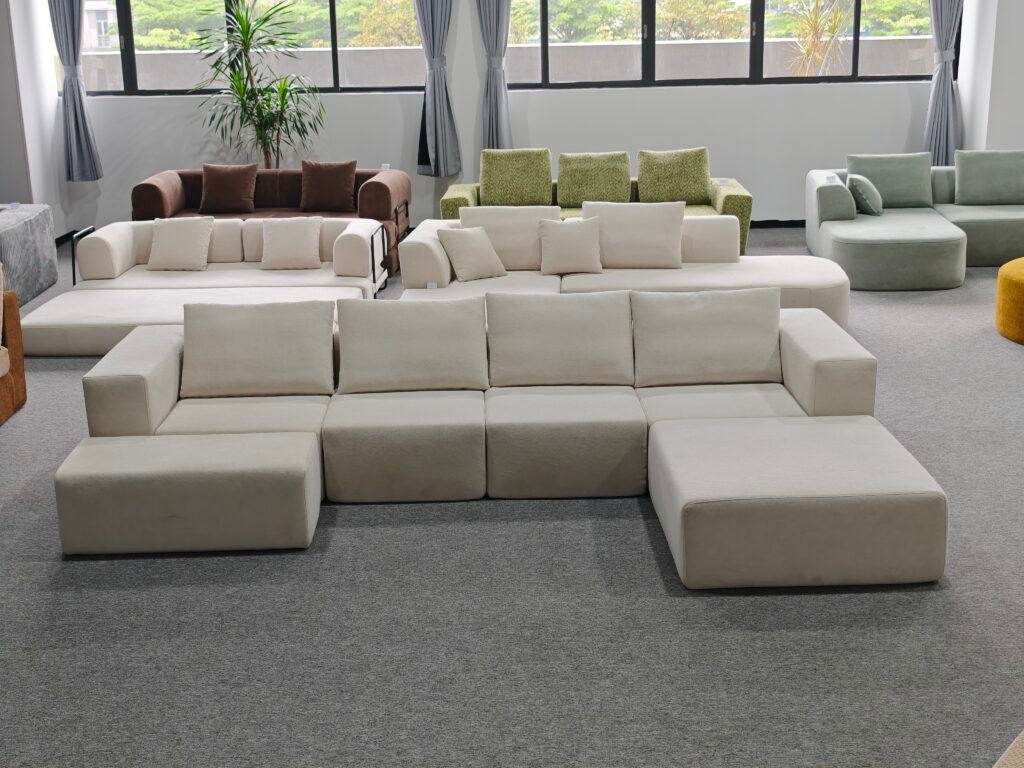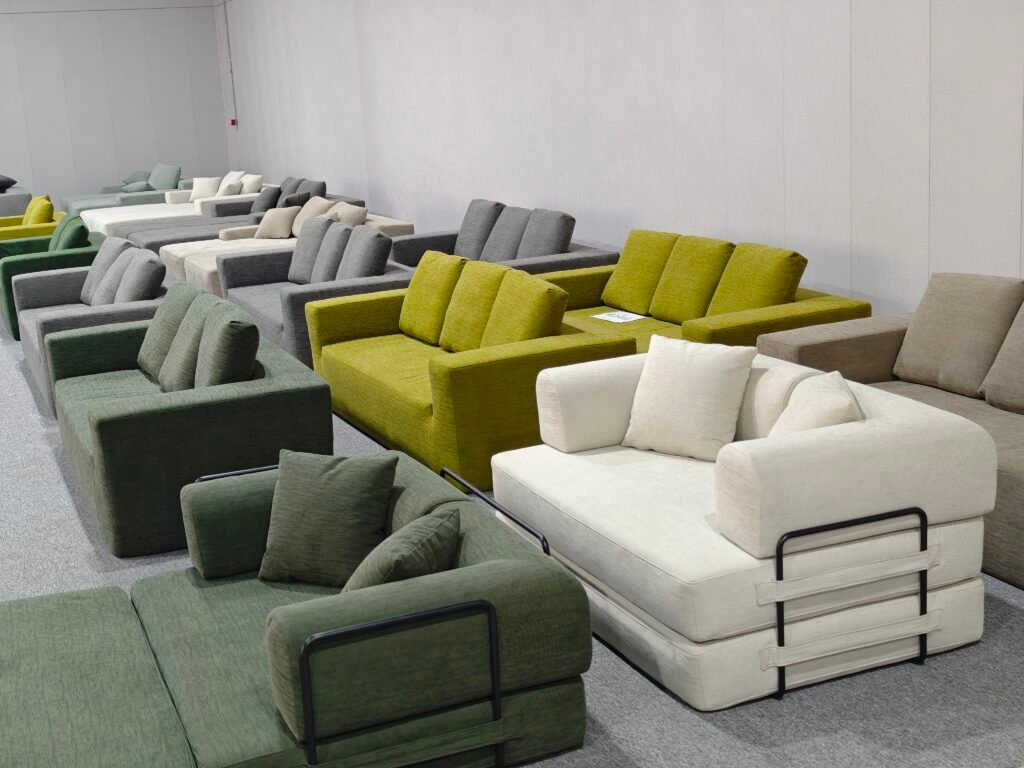Key Takeaways
- Space-saving and versatile, compression sofas are perfect for small homes, apartments, and flexible living spaces.
- Innovative features such as high-density foam, durable fabrics, and eco-friendly materials are incorporated to provide comfort and sustainability in many compression sofa models.
- state-of-the-art vacuum compression technology to reduce shipping costs and environmental footprint without compromising the sofa’s durability in transit.
- Unbox your compression sofa and assemble – it’s that simple, that fast, that easy, anywhere in the world!
- These sofas are quite economical, providing a good bang for your buck without sacrificing quality or design.
- It encourages sustainable living as it minimizes waste and advocates for environmentally responsible production.
Compress sofas are compact sofas that compress down for easier placement or moving. Typically, these sofas utilize either foldable frames or sectional cushions to compress moving or storing, perfect for small apartments, offices, or transient environments. Most designs incorporate strong steel or wood frames and plush, quick-clean fabrics for everyday use. A few compress sofas even arrive in flat-pack boxes, which reduces shipping expenses and accelerates setup. Popular choices are fold-outs, reclining sectionals and built-in storage sofas. For consumers, we’re talking about frame durability, fabric abrasion and how quickly you can configure or store your couch. The next section discusses styles, specifications and things to watch for when choosing compress sofas.


What is a Compression Sofa?
We’re calling it a compression sofa – the new-age seating solution designed for those of us who want to compress space and carry couches with less strain. These sofas compress or fold down to a significantly smaller size, making them simple to ship, transport or store as well. They’re different from regular sofas because they’re constructed with proprietary high-density foam and no cumbersome frames or springs. Compression sofas debuted in 2022, after compressed mattresses. Now, they suit the lifestyle of small apartment-dwelling, cohabitating or constantly traveling people.
1. The Core Concept
Compression sofas depend upon the concept of compressing huge seating into something manageable. By eliminating traditional wooden frames and springs, they employ dense foam which can be compressed and squeezed completely flat for packing. This makes them so much more convenient to relocate than old school sofas. Their modular construction allows consumers to select specific sizes or forms, and certain designs even allow you to move around segments as required. This approach clicks with rapid-fire urban life, where space is at a premium and needs evolve rapidly. For instance, a tight studio might utilize a compression sofa that opens up for guests, then compresses to free up floor space during the day.
2. The Materials
The majority of compression sofas use high-density foam, typically rated between 38 to 45 density. This foam is softer than traditional sofa foam, allowing it to rebound after being unpacked. The external cover is typically a sturdy synthetic or blended fabric, and not real leather, as it doesn’t compress nicely. Certain brands include a waterproof overlay, however, this tends to wear off within three to five years. Recently, more companies are experimenting with recycled or plant-based fabrics to reduce waste. The small number of designs—less than 20 currently available—are a testament to the requirement of rugged, uncomplicated materials that can withstand repeated compression.
3. The Technology
Compression sofas employ vacuum compression methods. Once assembled, the sofa is put in a heavy-duty bag and air is vacuumed out, compressing it down to a fraction of its size. It reduces shipping costs and carbon footprint because more units go in a container. Due to the foam’s resilience, it bounces back with minimal harm – even from extended journeys. Some brands have optimized the process by including quick-release valves or double-layer bags to protect the sofa and accelerate setup for customers.
4. The Unboxing
Unpacking a compression sofa is quick and easy. The package is light – so a single person can walk it in and open it. Once you slice open the bag, the foam rapidly expands, nearing its full dimensions within just a few hours. It’s a little magical seeing a flat bundle transform into a sofa. Other models come with spare covers, basic tools or a care kit for easier installation and maintenance. Although there may be some initial wrinkling, the majority compress out with time, delivering consumers a happy medium of convenience and coziness.
How Compression Technology Works
Similar to vacuum-sealed bedding, these companies take large, soft furniture and make it much smaller for shipping and storage. Manufacturers either use vacuum-packed bags or roll the sofa up tight, cutting down on its volume. Most of the time, it’s the sofa’s foam layers—think high-density, high-polymer—that get squished. This decrease in bulk volume allows a full-size sofa to fit in a box that slides through doors or can sit atop a standard pallet. The point is to save space, reduce expenses and get the couch home to consumers intact.
The steps begin at the factory. Employees or devices fold, roll, or compress the sofa until it’s as compact as possible. High-resilience foams, like memory foam, are crucial as they spring back after being compressed. These foams retain the sofa’s form and provide it durability to endure moves and assembly. As soon as the sofa is compressed, it slips into a heavy-duty plastic bag. Then a vacuum pump extracts all the air. This keeps the pack compact and flat causing every unit to stack efficiently on trucks or in containers.
Removing air has an additional advantage. It protects the sofa from dust, damp and dings in shipping. Since the pack is vacuum-sealed, your sofa can’t shift or bend too much – protecting your fabric from any dents or tears. Contained within modern compression sofas are strong foams and flexible fabrics—like luxury textiles, aerobic cotton, or high-polymer foam—so they don’t get ruined during this stage. Frequently, these sofas can be compressed and rejuvenated multiple times, which is great for people who move frequently or have limited spaces.
When buyers unpack the vacuum pack at home, air rushes right back in and the sofa puffs up quick—generally within minutes. No tools or pro needed to set up. To maximize your compressed sofa, it’s wise to allow it to expand fully before sitting or applying any pressure. This ensures the foam returns to its original shape, keeping the sofa firm and comfortable for years to come.


Compressed Sofa Advantages
Compressed sofas have altered the furniture landscape for a lot of us, especially those who appreciate room, adaptability, and streamlined living. Tailored for contemporary lifestyles, these sofas provide benefits that align well with urban living, constant relocation, and the drive for more intelligent, sustainable living.
Convenience
- Small package, big convenience – compressed sofas are simple to transport, simple to stow, and fit into snug areas. City residents can hoist a full-sized sofa up tight stairs or miniature elevators with ease. That makes them a convenient option for apartments, dorms, and communal housing.
- Easy to put together and take apart, it saves you time and energy. Certain designs deploy in merely 3 - 5 seconds, requiring no tools or additional components. This rapid transition from box to sofa allows consumers to settle in immediately.
- Space-savers is another huge advantage. Compressed sofas occupy 70-80% less space than normal sofas. This aids those with small storage spaces, allowing them to enjoy their rooms for more than just furniture.
- Lightweight construction makes handling and rearranging easy. Not like those massive, cumbersome couches—compressed sofas can be scooped up, transported or re-packed on a whim—perfect for tenants or anyone who relocates frequently.
Affordability
- There are lots of economical choices, at price points for various requirements.
- Because we ship in small, light packages, shipping’s much, much cheaper and those savings get passed on to buyers.
- Value for money is clear: even mid-range models use high-density foam, offering both comfort and durability.
- They’re discovering they can get up-to-the-minute styles and dual-purpose pieces – such as sofa beds – without paying a premium for size or designer labels.
Sustainability
- A number of compressed sofas are made from eco-friendly materials like recycled textiles or FSC-certified wood. That translates into reduced environmental impact.
- Heavy density foam in good models holds its form for eons. This cuts down on waste because the sofa endures for a long time and doesn’t have to be replaced as frequently.
- The industry is green. Some firms embrace water-based glues, and use little packaging and smart logistics to reduce their carbon footprint.
- Minimalist, eco-conscious buyers frequently opt for compressed sofas. They dig the combination of utility, convenience and ethical materials.
Potential Drawbacks
Compress sofas, typically constructed with foam and lightweight frames, seem like a wise choice for price and convenient shipping. There are some actual drawbacks prospective buyers should consider. The table below summarizes typical problems with compress sofas and solutions.
| Drawback | Solution |
|---|---|
| Sagging and unevenness | Choose denser foam, check for reinforced base |
| Quick wear and tear | Look for higher quality foam, regular checks |
| Less stability for heavy users | Find models with steel or hardwood frames |
| Traps heat, gets warm | Use covers with breathable fabric, air out sofa |
| Allergen build-up, chemical smell | Pick certified low-VOC foams, clean often |
| Hard to maintain | Go for removable, washable covers |
| May cost more in long run | Compare warranty and replacement rates |
Comfort is a major concern. Pack and ship sofas, especially with low density foam, can not compare to traditional spring or mixed fill sofa. Within just a few months, the foam flattens and sags. Users could get fidgety or even back aches from shoddy support! For the long sitters, a compress sofa may not provide the same comfort as a classic construction. Foam cushions are heat traps, which can make a sofa less enjoyable in warm weather.
Wear is still another. Foam sofas, despite their inexpensive initial cost, typically suffer from an early demise. The frames for these are not heavy-duty and would likely not hold up to heavy use or larger users. Sagging, uneven seats or even frame cracks can develop after just a little while. Steel or solid wood frame sofas endure for years and require less maintenance. Foam traps dust and allergens, leading to health issues for certain individuals. Certain cheap variants can even use foams that emit harsh chemical odors, causing indoor air quality concerns.
Choosing the appropriate model requires care. The market is flooded with compress sofas but not all compress sofas are created equal. Quality is all over the place between brands and makers. Some skimp by using thin foam or flimsy frames to cut expense. It’s wise for consumers to look for certifications, read user reviews and inquire about foam density and frame style. Choosing one with removable covers will make washing way easier and extend the life of the sofa.
Who Needs This Sofa?
Compression sofas are great for anybody looking for clever living solutions. The primary audience is urbanites and small-house residents. In compact flats or studios, each meter counts. Our compression sofa squeezes into narrow halls and small lifts with our compact box. Once inside, it pops open no tools necessary. This assists those of us who are single or have bare bones schedules. For renters or frequent movers, fast-assembly and easy transport streamline life—no need for movers or added help.
They come in handy for people who desire more from their furniture as well. The sofa converts into a bed in seconds. If you have visitors or family come stay, that’s no additional mattresses or folding beds. Students, young workers or anyone starting out can score with rates as low as $319. This way it’s easier to afford to be modern with a sleeping spot.
Mess and wear is a concern to busy homes, or pet owners. Compression sofas use durable and washable covers, so pet hair or spills are no problem. The frame and fabric can last 15+ years, so you’re making a smart buy for value and less waste. Pet/small-kid-owners require a sofa that lasts, and this one goes the distance.
These sofas utilize plush foam and soft fabrics that are made to feel good to sit on every day. Simple, clean, modern look that will suit most home styles. For the mobile bunch, no-tool setup or moving equals more freedom, less waiting and no back breaking lifting. This sofa works for everyone from students to retirees.
The Sustainability Impact
Compression furniture is where the impact of compression technology gets real gains for the planet. By miniaturizing sofas for transport and warehousing, that equates to less materials, less pollution, less everything. A compressed sofa consumes as much as 70% less volume while shipping. This volume reduction reduces the containers required, which reduces fuel consumption and carbon emissions. Less trucks and ships mean less smog in the air. Less packaging means less plastic and cardboard in the landfill. In dense cities or export markets where shipping costs and shelf space are precious, these savings add up quickly.
Long-lasting couches have an outsized impact on waste reduction. When a sofa endures, you don’t have to chuck it and get a new one every few years. A durable couch can generate just half the landfill as one that needs to be replaced fast. It’s not just the frame or fabric—how a sofa is constructed, compressed and delivered counts as well. Using better materials and smart designs means fewer products are made and less energy is expended at the factory. Consider, for instance, a sofa — one constructed with a strong steel frame and sturdy fabric remains serviceable for far longer, and thus saves resources in the long run.
Selecting a compression sofa is a tiny yet mighty stride for buyers looking to live a little greener. Sustainability lurks everywhere in life, from your meal choice to your seating. By choosing sofas engineered for durability and shipping efficiency, consumers reduce their carbon footprint. Routine maintenance — such as vacuuming, flipping springs or mending small tears — keeps couches and chairs going for years. That means less waste and less need to make that store run. For B2B buyers, these points hold even greater importance. They seek sofas that fulfill quality and sustainability requirements, as less replacement reduces the total cost of ownership.
Green furniture is not merely a fad, it is rapidly becoming an essential for contemporary spaces. Consumers globally want more than style, they want products that demonstrate care for the planet. Compressed sofas ticked all these boxes, combining clever design, less waste and performance up to global standards.


Conclusion
Compressed sofas provide more than just a room-saving hack. These sofas unlock possibilities for petite apartments, rapid relocations or volume purchases. You receive quick installation, simple relocations and reduced replacement, all in one. Our reinforced steel frame and secure wrap protects every sofa until it arrives in your home. Packing – and shipping costs – are reduced, so you save time and money. A lot of people discover that these sofas fit perfectly into urban living, roommates, or new beginnings in new locations. Some will crave more cushion or swoop style selections, but the majority appreciate the simplicity and quickness. Need more info or a sample? Contact us and find out how a compress sofa could work for your next project.
Frequently Asked Questions
What is a compression sofa?
A compression sofa is a couch that’s vacuum-packed or compressed nice and tight for convenient shipment and delivery. It decompresses to full size after opening.
How do I set up a compressed sofa at home?
Just take off the packaging, allow the sofa to decompress and adhere to the instructions enclosed. The majority of sofas will completely open up in 24 – 48 hours.
Are compressed sofas as comfortable as traditional sofas?
Sure, a lot of compressed sofas utilize the same high-end foam and materials. Once expanded, they can be equally as comfortable as regular sofas.
Can I move a compressed sofa by myself?
Because they’re compact and lighter, compressed sofas are easier to move around prior to unpacking. Once decompressed, they can sometimes need two people to carry.
Are compressed sofas durable?
A lot of these compressed sofas are actually quite well made, with solid frames and heavy-duty fabric. As always, consult product reviews and materials details to confirm quality.
How do compressed sofas help the environment?
Compress sofas to take up less packaging and shipping space — reducing carbon emissions and waste. This makes them more sustainable.
Who benefits most from buying a compressed sofa?
Small space dwellers, frequent movers, or anyone looking for convenient delivery will love compressed sofas. They’re great for international shipping too.